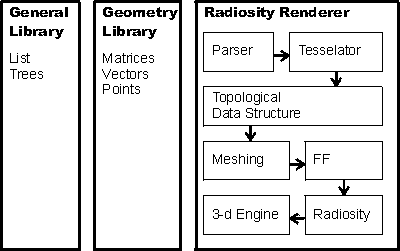Second Meeting
Location: MC4040
Date: Thursday, February 12, 1998
Time: 5:45 PM
Agenda
- Change the name of the SPP?
- Possibility of Wednesday meetings?
- Overview of structure of radiosity project
- Overview of radiosity
- Q&A
Summary
Because of a C&O 230 exam being held at the same time, many people could not show up for
the meeting. Because of this, only about ten people showed up, so the meeting was used for
general bookkeeping purposes.
Minutes
Change the name of the SPP?
- Some people have mentioned that the Student Programming Project sounds unprofessional
- Student Programming Project does have an OK acronym though (SPP)
- Discussed the possibility of starting with a cool acronym and then thinking of a matching
name
- Possibly one name for the radiosity project and another name for the group itself
- Some brainstorming but no good ideas
Possibility of Wednesday meetings?
- Some people can never show up on Thursdays
- Some people have business on Wednesdays
- Discussed possibility of alternating days
Overview of structure of radiosity project
- Overview by Mark Visser (this is my interpretation of it, so it may not be completely correct)

- Radiosity Renderer itself consists of seven of interconnected parts
- Starts with the parser which reads a text file description of the scene
- This information is sent to the tesselator which breaks down complex objects into polygons
- All this is stored in a special topological data structure which holds the polygon info in a
format which makes breaking polygons into smaller polygons easier (this is done a lot in
radiosity)
- This structure can also approximate a lot of smaller polygons with a big polygon etc. to speed
up calculations
- Meshing breaks down the polygons into smaller polygons
- This is sent to the form factor calculator which does some key calculation needed before
radiosity can be done
- Then there's the actual radiosity step which is actually not too difficult once the other steps
have taken place
- Afterwards, everything is sent to a 3-d engine for displaying the resulting image.
- The 3-d engine and parser are non-essential and can be borrowed from elsewhere
- The entire process relies upon a geometry library consisting of points, matrices, lines, and
other primitives
- This, in turn, relies upon a general library of lists and trees etc.
- Most of the work is actually in the geometry library
- Even if people don't understand how the radiosity works, the geometry library contains a lot
of simple concepts that they can work on
- The CS488 (Computer Graphics) lecture notes have detailed and readable info about radiosity
- These notes can be found at http://www.undergrad.math.uwaterloo.ca/~cs488
Overview of Radiosity
- Overview of polygons and stuff
- Most of it will be covered by a talk next week by Professor Steve Mann
Q&A
- Mark Visser managed to get Professor Steve Mann to give the SPP a talk on radiosity next
week
- Unfortunately, there's a CS240 mid-term next week on Thursday
- Possibly hold meeting on Wednesday, late Thursday, or Friday
- Discussed the merits of breaking into small groups so that people can work intensely and
in-depth on little parts vs. working as one large group where everyone sees how the whole
thing is designed
- Discussed possibility of setting a time line and deadlines
- Discussed possibility of where corners could be cut if time becomes short
- Discussed possibility of weekend meetings
[Home]
Last updated February 17, 1998.
Maintained by Ming-Yee Iu.

